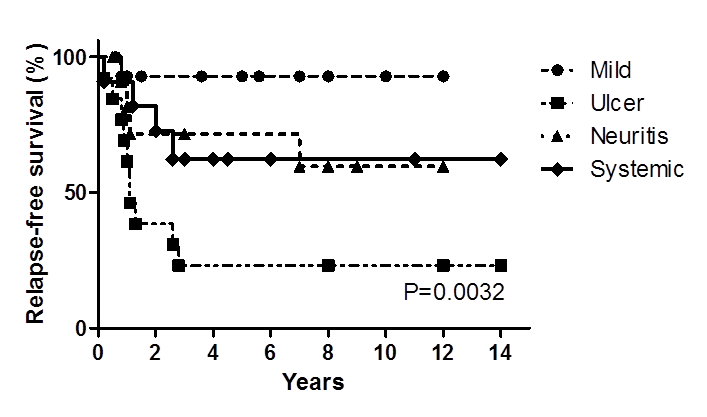Session Information
Session Type: ACR Poster Session C
Session Time: 9:00AM-11:00AM
Background/Purpose: Polyarteritis nodosa (PAN) is a necrotizing arteritis of medium and small arteries. PAN is divided into systemic and cutaneous PAN (cPAN). cPAN can be further classified into mild cPAN or severe cPAN in which ulcer, necrosis, or neuritis is observed. However, it is sometimes difficult to set a boundary between severe cPAN and systemic PAN, and their optimal treatments are still unclear. The aim of this study is to evaluate clinical characteristics of patients with necrotizing arteritis of medium and small arteries.
Methods: 50 patients who were diagnosed as necrotizing arteritis of medium and small arteries without glomerulonephritis or vasculitis in arterioles, capillaries, or venules during 2008-2016 in our institution were enrolled to this study. Clinical backgrounds, symptoms, laboratory findings including inflammatory markers and antineutrophil cytoplasmic antibodies (ANCA), affected organs, treatments, and the rates of relapse and death were retrospectively evaluated.
Results: Among 50 patients with necrotizing arteritis of medium and small arteries, 39 patients were classified as cPAN (mild, 18; ulcer or necrosis, 8; neuritis, 9; both, 4), and 11 cases manifested systemic vasculitis. One case of cPAN developed renal involvement. Clinical characteristics of mild cPAN included female predominance (94.4%) and younger age (median, 33), while severe cPAN and systemic type had no sex difference. The characteristics of systemic type included older age (median, 69), general symptoms, higher levels of inflammatory markers, lower levels of serum proteins, and organ damages. Severe cPAN manifested intermediate phenotypes. The positivity of autoantibodies in cPAN was about 30 %, while 81.8 % of systemic type possessed some autoantibodies. Particularly, 54.5 % of systemic type possessed myeloperoxidase (MPO)-ANCA though the titers were significantly lower than those of microscopic polyangiitis, suggesting non-specific elevation of MPO-ANCA in Japanese population. The median doses of PSL for mild cPAN, severe cPAN, and systemic type were 20, 40, 40 mg/day, respectively. Immunosuppressants were used in 20% of mild cPAN, 90% of severe cPAN, and 73% of systemic type. Although the mortality rates were indistinguishable, the relapse rates of cPAN with ulcer or necrosis were significantly higher than other types (p=0.0032, figure 1).
Conclusion: 22% of patients with necrotizing arteritis of medium and small arteries presented systemic vasculitis. The clinical characteristics of mild cPAN, cPAN with ulcer or necrosis, cPAN with neuritis, and systemic vasculitis were distinct from each other, suggesting that they should be managed differently. Particularly, cPAN with ulcer or necrosis showed high relapse rates, indicating unmet need to establish adequate treatments such as rituximab.
To cite this abstract in AMA style:
Shirai T, Fujii H, Fujita Y, Shirota Y, Ishii T, Harigae H. Four-Distinct Phenotypes of Patients with Necrotizing Arteritis of Medium and Small Arteries [abstract]. Arthritis Rheumatol. 2017; 69 (suppl 10). https://acrabstracts.org/abstract/four-distinct-phenotypes-of-patients-with-necrotizing-arteritis-of-medium-and-small-arteries/. Accessed .« Back to 2017 ACR/ARHP Annual Meeting
ACR Meeting Abstracts - https://acrabstracts.org/abstract/four-distinct-phenotypes-of-patients-with-necrotizing-arteritis-of-medium-and-small-arteries/

